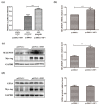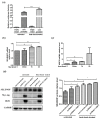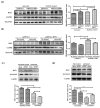Transcriptional Regulation of Selenoprotein F by Heat Shock Factor 1 during Selenium Supplementation and Stress Response
- PMID: 31109102
- PMCID: PMC6562903
- DOI: 10.3390/cells8050479
Transcriptional Regulation of Selenoprotein F by Heat Shock Factor 1 during Selenium Supplementation and Stress Response
Abstract
Changes of Selenoprotein F (SELENOF) protein levels have been reported during selenium supplementation, stressful, and pathological conditions. However, the mechanisms of how these external factors regulate SELENOF gene expression are largely unknown. In this study, HEK293T cells were chosen as an in vitro model. The 5'-flanking regions of SELENOF were analyzed for promoter features. Dual-Glo Luciferase assays were used to detect promoter activities. Putative binding sites of Heat Shock Factor 1 (HSF1) were predicted in silico and the associations were further proved by chromatin immunoprecipitation (ChIP) assay. Selenate and tunicamycin (Tm) treatment were used to induce SELENOF up-regulation. The fold changes in SELENOF expression and other relative proteins were analyzed by Q-PCR and western blot. Our results showed that selenate and Tm treatment up-regulated SELENOF at mRNA and protein levels. SELENOF 5'-flanking regions from -818 to -248 were identified as core positive regulatory element regions. Four putative HSF1 binding sites were predicted in regions from -1430 to -248, and six out of seven primers detected positive results in ChIP assay. HSF1 over-expression and heat shock activation increased the promoter activities, and mRNA and protein levels of SELENOF. Over-expression and knockdown of HSF1 showed transcriptional regulation effects on SELENOF during selenate and Tm treatment. In conclusion, HSF1 was discovered as one of the transcription factors that were associated with SELENOF 5'-flanking regions and mediated the up-regulation of SELENOF during selenate and Tm treatment. Our work has provided experimental data for the molecular mechanism of SELENOF gene regulation, as well as uncovered the involvement of HSF1 in selenotranscriptomic for the first time.
Keywords: ER stress; Selenoprotein F; heat shock; heat shock factor 1; selenium supplementation; transcription regulation.
Conflict of interest statement
The authors declare no conflict of interest.
Figures








Similar articles
-
Regulatory effect of heat shock transcription factor-1 gene on heat shock proteins and its transcriptional regulation analysis in small abalone Haliotis diversicolor.BMC Mol Cell Biol. 2020 Nov 24;21(1):83. doi: 10.1186/s12860-020-00323-9. BMC Mol Cell Biol. 2020. PMID: 33228519 Free PMC article.
-
Chromatin conformation remains stable upon extensive transcriptional changes driven by heat shock.Proc Natl Acad Sci U S A. 2019 Sep 24;116(39):19431-19439. doi: 10.1073/pnas.1901244116. Epub 2019 Sep 10. Proc Natl Acad Sci U S A. 2019. PMID: 31506350 Free PMC article.
-
Poly(ADP-Ribose) Polymerase 1 Promotes the Human Heat Shock Response by Facilitating Heat Shock Transcription Factor 1 Binding to DNA.Mol Cell Biol. 2018 Jun 14;38(13):e00051-18. doi: 10.1128/MCB.00051-18. Print 2018 Jul 1. Mol Cell Biol. 2018. PMID: 29661921 Free PMC article.
-
Role of Selenoprotein F in Protein Folding and Secretion: Potential Involvement in Human Disease.Nutrients. 2018 Nov 2;10(11):1619. doi: 10.3390/nu10111619. Nutrients. 2018. PMID: 30400132 Free PMC article. Review.
-
Rethinking HSF1 in Stress, Development, and Organismal Health.Trends Cell Biol. 2017 Dec;27(12):895-905. doi: 10.1016/j.tcb.2017.08.002. Epub 2017 Sep 7. Trends Cell Biol. 2017. PMID: 28890254 Free PMC article. Review.
Cited by
-
Selenium metabolism and selenoproteins function in brain and encephalopathy.Sci China Life Sci. 2025 Mar;68(3):628-656. doi: 10.1007/s11427-023-2621-7. Epub 2024 Nov 12. Sci China Life Sci. 2025. PMID: 39546178 Review.
-
Dietary Selenium Supplementation Ameliorates Female Reproductive Efficiency in Aging Mice.Antioxidants (Basel). 2019 Dec 11;8(12):634. doi: 10.3390/antiox8120634. Antioxidants (Basel). 2019. PMID: 31835711 Free PMC article.
-
Dietary Marginal and Excess Selenium Increased Triglycerides Deposition, Induced Endoplasmic Reticulum Stress and Differentially Influenced Selenoproteins Expression in the Anterior and Middle Intestines of Yellow Catfish Pelteobagrus fulvidraco.Antioxidants (Basel). 2021 Mar 29;10(4):535. doi: 10.3390/antiox10040535. Antioxidants (Basel). 2021. PMID: 33805536 Free PMC article.
-
Nano-selenium Supplementation Increases Selenoprotein (Sel) Gene Expression Profiles and Milk Selenium Concentration in Lactating Dairy Cows.Biol Trace Elem Res. 2021 Jan;199(1):113-119. doi: 10.1007/s12011-020-02139-2. Epub 2020 Apr 23. Biol Trace Elem Res. 2021. PMID: 32328970 Free PMC article.
-
Distinct Roles of SELENOF in Different Human Cancers.Biomolecules. 2023 Mar 6;13(3):486. doi: 10.3390/biom13030486. Biomolecules. 2023. PMID: 36979420 Free PMC article. Review.
References
Publication types
MeSH terms
Substances
LinkOut - more resources
Full Text Sources
Molecular Biology Databases

